How To Pass An Api Key From Outside Your App Tree
Flutter for React Native developers
- Introduction to Dart for JavaScript Developers
- Entry point
- Printing to the console
- Variables
- Creating and assigning variables
- Default value
- Checking for null or zero
- Functions
- Asynchronous programming
- Futures
- async and await
- The basics
- How do I create a Flutter app?
- How do I run my app?
- How do I import widgets?
- What is the equivalent of the React Native "Hello world!" app in Flutter?
- How do I use widgets and nest them to form a widget tree?
- How do I create reusable components?
- Project structure and resources
- Where do I start writing the code?
- How are files structured in a Flutter app?
- Where do I put my resources and assets and how do I use them?
- How do I load images over a network?
- How do I install packages and package plugins?
- Flutter widgets
- Views
- What is the equivalent of the View container?
- What is the equivalent of FlatList or SectionList?
- How do I use a Canvas to draw or paint?
- Layouts
- How do I use widgets to define layout properties?
- How do I layer widgets?
- Styling
- How do I style my components?
- How do I use Icons and Colors?
- How do I add style themes?
- State management
- The StatelessWidget
- The StatefulWidget
- What are the StatefulWidget and StatelessWidget best practices?
- Props
- Local storage
- How do I store persistent key-value pairs that are global to the app?
- Routing
- How do I navigate between screens?
- How do I use tab navigation and drawer navigation?
- Tab navigation
- Drawer navigation
- Gesture detection and touch event handling
- How do I add a click or press listeners to a widget?
- Making HTTP network requests
- How do I fetch data from API calls?
- Form input
- How do I use text field widgets?
- How do I use Form widgets?
- Platform-specific code
- Debugging
- What tools can I use to debug my app in Flutter?
- How do I perform a hot reload?
- How do I access the in-app developer menu?
- Animation
- How do I add a simple fade-in animation?
- How do I add swipe animation to cards?
- React Native and Flutter widget equivalent components
This document is for React Native (RN) developers looking to apply their existing RN knowledge to build mobile apps with Flutter. If you understand the fundamentals of the RN framework then you can use this document as a way to get started learning Flutter development.
This document can be used as a cookbook by jumping around and finding questions that are most relevant to your needs.
Introduction to Dart for JavaScript Developers
Like React Native, Flutter uses reactive-style views. However, while RN transpiles to native widgets, Flutter compiles all the way to native code. Flutter controls each pixel on the screen, which avoids performance problems caused by the need for a JavaScript bridge.
Dart is an easy language to learn and offers the following features:
- Provides an open-source, scalable programming language for building web, server, and mobile apps.
- Provides an object-oriented, single inheritance language that uses a C-style syntax that is AOT-compiled into native.
- Transcompiles optionally into JavaScript.
- Supports interfaces and abstract classes.
A few examples of the differences between JavaScript and Dart are described below.
Entry point
JavaScript doesn't have a pre-defined entry function—you define the entry point.
// JavaScript function startHere () { // Can be used as entry point } In Dart, every app must have a top-level main() function that serves as the entry point to the app.
Try it out in DartPad.
Printing to the console
To print to the console in Dart, use print().
// JavaScript console . log ( ' Hello world! ' ); // Dart print ( 'Hello world!' ); Try it out in DartPad.
Variables
Dart is type safe—it uses a combination of static type checking and runtime checks to ensure that a variable's value always matches the variable's static type. Although types are mandatory, some type annotations are optional because Dart performs type inference.
Creating and assigning variables
In JavaScript, variables cannot be typed.
In Dart, variables must either be explicitly typed or the type system must infer the proper type automatically.
// JavaScript var name = ' JavaScript ' ; // Dart String name = 'dart' ; // Explicitly typed as a string. var otherName = 'Dart' ; // Inferred string. // Both are acceptable in Dart. Try it out in DartPad.
For more information, see Dart's Type System.
Default value
In JavaScript, uninitialized variables are undefined.
In Dart, uninitialized variables have an initial value of null. Because numbers are objects in Dart, even uninitialized variables with numeric types have the value null.
// JavaScript var name ; // == undefined // Dart var name ; // == null int x ; // == null Try it out in DartPad.
For more information, see the documentation on variables.
Checking for null or zero
In JavaScript, values of 1 or any non-null objects are treated as true.
// JavaScript var myNull = null ; if ( ! myNull ) { console . log ( ' null is treated as false ' ); } var zero = 0 ; if ( ! zero ) { console . log ( ' 0 is treated as false ' ); } In Dart, only the boolean value true is treated as true.
// Dart var myNull = null ; if ( myNull == null ) { print ( 'use "== null" to check null' ); } var zero = 0 ; if ( zero == 0 ) { print ( 'use "== 0" to check zero' ); } Try it out in DartPad.
Functions
Dart and JavaScript functions are generally similar. The primary difference is the declaration.
// JavaScript function fn () { return true ; } // Dart fn () { return true ; } // can also be written as bool fn ( ) { return true ; } Try it out in DartPad.
For more information, see the documentation on functions.
Asynchronous programming
Futures
Like JavaScript, Dart supports single-threaded execution. In JavaScript, the Promise object represents the eventual completion (or failure) of an asynchronous operation and its resulting value.
Dart uses Future objects to handle this.
// JavaScript class Example { _getIPAddress () { const url = ' https://httpbin.org/ip ' ; return fetch ( url ) . then ( response => response . json ()) . then ( responseJson => { const ip = responseJson . origin ; return ip ; }); } } function main () { const example = new Example (); example . _getIPAddress () . then ( ip => console . log ( ip )) . catch ( error => console . error ( error )); } main (); // Dart import 'dart:convert' ; import 'package:http/http.dart' as http ; class Example { Future < String > _getIPAddress () { final url = 'https://httpbin.org/ip' ; return http . get ( url ). then (( response ) { String ip = jsonDecode ( response . body )[ 'origin' ]; return ip ; }); } } main () { final example = new Example (); example . _getIPAddress () . then (( ip ) => print ( ip )) . catchError (( error ) => print ( error )); } For more information, see the documentation on Future objects.
async and await
The async function declaration defines an asynchronous function.
In JavaScript, the async function returns a Promise. The await operator is used to wait for a Promise.
// JavaScript class Example { async function _getIPAddress () { const url = ' https://httpbin.org/ip ' ; const response = await fetch ( url ); const json = await response . json (); const data = json . origin ; return data ; } } async function main () { const example = new Example (); try { const ip = await example . _getIPAddress (); console . log ( ip ); } catch ( error ) { console . error ( error ); } } main (); In Dart, an async function returns a Future, and the body of the function is scheduled for execution later. The await operator is used to wait for a Future.
// Dart import 'dart:convert' ; import 'package:http/http.dart' as http ; class Example { Future < String > _getIPAddress () async { final url = 'https://httpbin.org/ip' ; final response = await http . get ( url ); String ip = jsonDecode ( response . body )[ 'origin' ]; return ip ; } } main () async { final example = new Example (); try { final ip = await example . _getIPAddress (); print ( ip ); } catch ( error ) { print ( error ); } } For more information, see the documentation for async and await.
The basics
How do I create a Flutter app?
To create an app using React Native, you would run create-react-native-app from the command line.
$ create-react-native-app <projectname> To create an app in Flutter, do one of the following:
- Use an IDE with the Flutter and Dart plugins installed.
- Use the
flutter createcommand from the command line. Make sure that the Flutter SDK is in your PATH.
$ flutter create <projectname> For more information, see Getting started, which walks you through creating a button-click counter app. Creating a Flutter project builds all the files that you need to run a sample app on both Android and iOS devices.
How do I run my app?
In React Native, you would run npm run or yarn run from the project directory.
You can run Flutter apps in a couple of ways:
- Use the "run" option in an IDE with the Flutter and Dart plugins.
- Use
flutter runfrom the project's root directory.
Your app runs on a connected device, the iOS simulator, or the Android emulator.
For more information, see the Flutter Getting started documentation.
How do I import widgets?
In React Native, you need to import each required component.
//React Native import React from ' react ' ; import { StyleSheet , Text , View } from ' react-native ' ; In Flutter, to use widgets from the Material Design library, import the material.dart package. To use iOS style widgets, import the Cupertino library. To use a more basic widget set, import the Widgets library. Or, you can write your own widget library and import that.
import 'package:flutter/material.dart' ; import 'package:flutter/cupertino.dart' ; import 'package:flutter/widgets.dart' ; import 'package:flutter/my_widgets.dart' ; Whichever widget package you import, Dart pulls in only the widgets that are used in your app.
For more information, see the Flutter Widget Catalog.
What is the equivalent of the React Native "Hello world!" app in Flutter?
In React Native, the HelloWorldApp class extends React.Component and implements the render method by returning a view component.
// React Native import React from ' react ' ; import { StyleSheet , Text , View } from ' react-native ' ; export default class App extends React . Component { render () { return ( < View style = { styles . container } > < Text > Hello world !< /Text > < /View > ); } } const styles = StyleSheet . create ({ container : { flex : 1 , backgroundColor : ' #fff ' , alignItems : ' center ' , justifyContent : ' center ' } }); In Flutter, you can create an identical "Hello world!" app using the Center and Text widgets from the core widget library. The Center widget becomes the root of the widget tree and has one child, the Text widget.
// Flutter import 'package:flutter/material.dart' ; void main ( ) { runApp ( Center ( child: Text ( 'Hello, world!' , textDirection: TextDirection . ltr , ), ), ); } The following images show the Android and iOS UI for the basic Flutter "Hello world!" app.
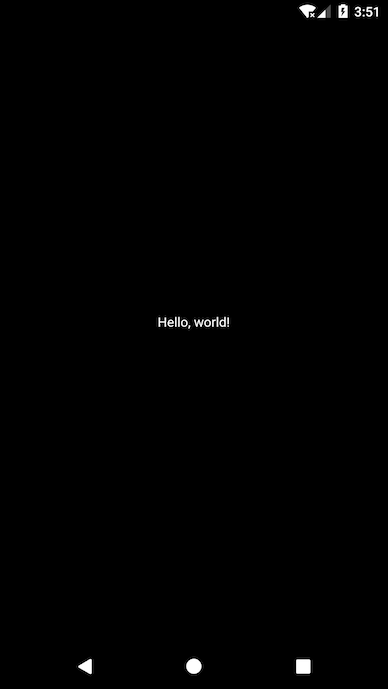

Now that you've seen the most basic Flutter app, the next section shows how to take advantage of Flutter's rich widget libraries to create a modern, polished app.
How do I use widgets and nest them to form a widget tree?
In Flutter, almost everything is a widget.
Widgets are the basic building blocks of an app's user interface. You compose widgets into a hierarchy, called a widget tree. Each widget nests inside a parent widget and inherits properties from its parent. Even the application object itself is a widget. There is no separate "application" object. Instead, the root widget serves this role.
A widget can define:
- A structural element—like a button or menu
- A stylistic element—like a font or color scheme
- An aspect of layout—like padding or alignment
The following example shows the "Hello world!" app using widgets from the Material library. In this example, the widget tree is nested inside the MaterialApp root widget.
// Flutter import 'package:flutter/material.dart' ; void main ( ) => runApp ( MyApp ()); class MyApp extends StatelessWidget { @override Widget build ( BuildContext context ) { return MaterialApp ( title: 'Welcome to Flutter' , home: Scaffold ( appBar: AppBar ( title: Text ( 'Welcome to Flutter' ), ), body: Center ( child: Text ( 'Hello world' ), ), ), ); } } The following images show "Hello world!" built from Material Design widgets. You get more functionality for free than in the basic "Hello world!" app.
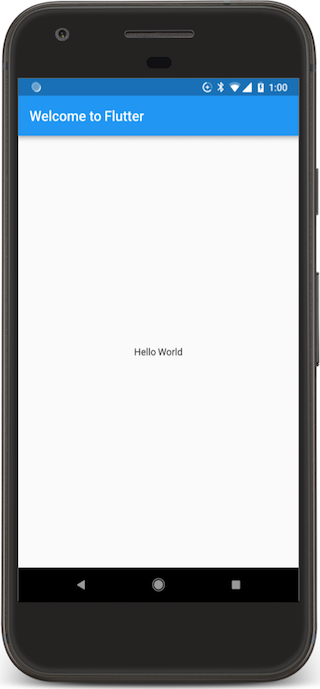

When writing an app, you'll use two types of widgets: StatelessWidget or StatefulWidget. A StatelessWidget is just what it sounds like—a widget with no state. A StatelessWidget is created once, and never changes its appearance. A StatefulWidget dynamically changes state based on data received, or user input.
The important difference between stateless and stateful widgets is that StatefulWidgets have a State object that stores state data and carries it over across tree rebuilds, so it's not lost.
In simple or basic apps it's easy to nest widgets, but as the code base gets larger and the app becomes complex, you should break deeply nested widgets into functions that return the widget or smaller classes. Creating separate functions and widgets allows you to reuse the components within the app.
How do I create reusable components?
In React Native, you would define a class to create a reusable component and then use props methods to set or return properties and values of the selected elements. In the example below, the CustomCard class is defined and then used inside a parent class.
// React Native class CustomCard extends React . Component { render () { return ( < View > < Text > Card { this . props . index } < /Text > < Button title = " Press " onPress = {() => this . props . onPress ( this . props . index )} / > < /View > ); } } // Usage < CustomCard onPress = { this . onPress } index = { item . key } / > In Flutter, define a class to create a custom widget and then reuse the widget. You can also define and call a function that returns a reusable widget as shown in the build function in the following example.
// Flutter class CustomCard extends StatelessWidget { CustomCard ({ @required this . index , @required this . onPress }); final index ; final Function onPress ; @override Widget build ( BuildContext context ) { return Card ( child: Column ( children: < Widget >[ Text ( 'Card $index ' ), TextButton ( child: const Text ( 'Press' ), onPressed: this . onPress , ), ], ) ); } } ... // Usage CustomCard ( index: index , onPress: () { print ( 'Card $index ' ); }, ) ... In the previous example, the constructor for the CustomCard class uses Dart's curly brace syntax { } to indicate named optional parameters.
To require these fields, either remove the curly braces from the constructor, or add @required to the constructor.
The following screenshots show an example of the reusable CustomCard class.
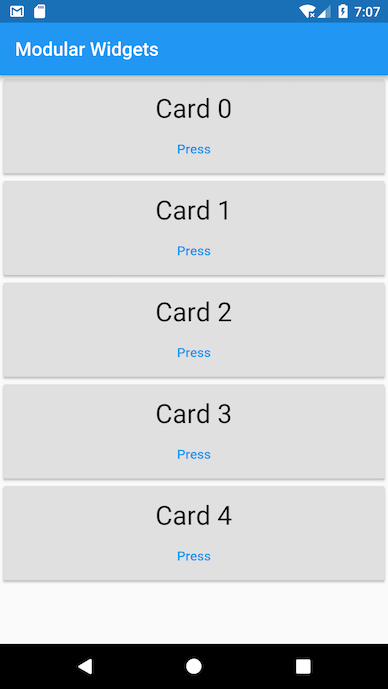

Project structure and resources
Where do I start writing the code?
Start with the lib/main.dart file. It's autogenerated when you create a Flutter app.
// Dart void main ( ){ print ( 'Hello, this is the main function.' ); } In Flutter, the entry point file is 'projectname'/lib/main.dart and execution starts from the main function.
How are files structured in a Flutter app?
When you create a new Flutter project, it builds the following directory structure. You can customize it later, but this is where you start.
┬ └ projectname ┬ ├ android - Contains Android-specific files. ├ build - Stores iOS and Android build files. ├ ios - Contains iOS-specific files. ├ lib - Contains externally accessible Dart source files. ┬ └ src - Contains additional source files. └ main.dart - The Flutter entry point and the start of a new app. This is generated automatically when you create a Flutter project. It's where you start writing your Dart code. ├ test - Contains automated test files. └ pubspec.yaml - Contains the metadata for the Flutter app. This is equivalent to the package.json file in React Native. Where do I put my resources and assets and how do I use them?
A Flutter resource or asset is a file that is bundled and deployed with your app and is accessible at runtime. Flutter apps can include the following asset types:
- Static data such as JSON files
- Configuration files
- Icons and images (JPEG, PNG, GIF, Animated GIF, WebP, Animated WebP, BMP, and WBMP)
Flutter uses the pubspec.yaml file, located at the root of your project, to identify assets required by an app.
flutter : assets : - assets/my_icon.png - assets/background.png The assets subsection specifies files that should be included with the app. Each asset is identified by an explicit path relative to thepubspec.yaml file, where the asset file is located. The order in which the assets are declared does not matter. The actual directory used (assets in this case) does not matter. However, while assets can be placed in any app directory, it's a best practice to place them in the assets directory.
During a build, Flutter places assets into a special archive called theasset bundle, which apps read from at runtime. When an asset's path is specified in the assets section of pubspec.yaml, the build process looks for any files with the same name in adjacent subdirectories. These files are also included in the asset bundle along with the specified asset. Flutter uses asset variants when choosing resolution-appropriate images for your app.
In React Native, you would add a static image by placing the image file in a source code directory and referencing it.
< Image source = { require ( ' ./my-icon.png ' )} / > In Flutter, add a static image to your app using the AssetImage class in a widget's build method.
image: AssetImage ( 'assets/background.png' ), For more information, see Adding Assets and Images in Flutter.
How do I load images over a network?
In React Native, you would specify the uri in the source prop of the Image component and also provide the size if needed.
In Flutter, use the Image.network constructor to include an image from a URL.
// Flutter body: Image . network ( 'https://flutter.io/images/owl.jpg' , How do I install packages and package plugins?
Flutter supports using shared packages contributed by other developers to the Flutter and Dart ecosystems. This allows you to quickly build your app without having to develop everything from scratch. Packages that contain platform-specific code are known as package plugins.
In React Native, you would use yarn add {package-name} or npm install --save {package-name} to install packages from the command line.
In Flutter, install a package using the following instructions:
- Add the package name and version to the
pubspec.yamldependencies section. The example below shows how to add thegoogle_sign_inDart package to thepubspec.yamlfile. Check your spaces when working in the YAML file because white space matters!
dependencies : flutter : sdk : flutter google_sign_in : ^3.0.3 - Install the package from the command line by using
flutter pub get. If using an IDE, it often runsflutter pub getfor you, or it might prompt you to do so. - Import the package into your app code as shown below:
import 'package:google_sign_in/google_sign_in.dart' ; For more information, see Using Packages and Developing Packages & Plugins.
You can find many packages shared by Flutter developers in the Flutter packages section of pub.dev.
In Flutter, you build your UI out of widgets that describe what their view should look like given their current configuration and state.
Widgets are often composed of many small, single-purpose widgets that are nested to produce powerful effects. For example, the Container widget consists of several widgets responsible for layout, painting, positioning, and sizing. Specifically, the Container widget includes theLimitedBox, ConstrainedBox,Align, Padding,DecoratedBox, andTransform widgets. Rather than subclassing Container to produce a customized effect, you can compose these and other simple widgets in new and unique ways.
The Center widget is another example of how you can control the layout. To center a widget, wrap it in a Center widget and then use layout widgets for alignment, row, columns, and grids. These layout widgets do not have a visual representation of their own. Instead, their sole purpose is to control some aspect of another widget's layout. To understand why a widget renders in a certain way, it's often helpful to inspect the neighboring widgets.
For more information, see the Flutter Technical Overview.
For more information about the core widgets from the Widgets package, see Flutter Basic Widgets, the Flutter Widget Catalog, or the Flutter Widget Index.
Views
What is the equivalent of the View container?
In React Native, View is a container that supports layout with Flexbox, style, touch handling, and accessibility controls.
In Flutter, you can use the core layout widgets in the Widgets library, such as Container, Column, Row, and Center. For more information, see the Layout Widgets catalog.
What is the equivalent of FlatList or SectionList?
A List is a scrollable list of components arranged vertically.
In React Native, FlatList or SectionList are used to render simple or sectioned lists.
// React Native < FlatList data = {[ ... ]} renderItem = {({ item }) => < Text > { item . key } < /Text> } /> ListView is Flutter's most commonly used scrolling widget. The default constructor takes an explicit list of children. ListView is most appropriate for a small number of widgets. For a large or infinite list, use ListView.builder, which builds its children on demand and only builds those children that are visible.
// Flutter var data = [ ... ]; ListView . builder ( itemCount: data . length , itemBuilder: ( context , int index ) { return Text ( data [ index ], ); }, ) 
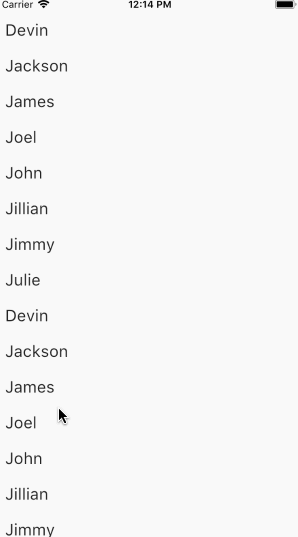
To learn how to implement an infinite scrolling list, see the Write Your First Flutter App, Part 1 codelab.
How do I use a Canvas to draw or paint?
In React Native, canvas components aren't present so third party libraries like react-native-canvas are used.
// React Native handleCanvas = canvas => { const ctx = canvas . getContext ( ' 2d ' ); ctx . fillStyle = ' skyblue ' ; ctx . beginPath (); ctx . arc ( 75 , 75 , 50 , 0 , 2 * Math . PI ); ctx . fillRect ( 150 , 100 , 300 , 300 ); ctx . stroke (); }; render () { return ( < View > < Canvas ref = { this . handleCanvas } / > < /View > ); } In Flutter, you can use the CustomPaint and CustomPainter classes to draw to the canvas.
The following example shows how to draw during the paint phase using the CustomPaint widget. It implements the abstract class, CustomPainter, and passes it to CustomPaint's painter property. CustomPaint subclasses must implement the paint() and shouldRepaint() methods.
// Flutter class MyCanvasPainter extends CustomPainter { @override void paint ( Canvas canvas , Size size ) { Paint paint = Paint (); paint . color = Colors . amber ; canvas . drawCircle ( Offset ( 100.0 , 200.0 ), 40.0 , paint ); Paint paintRect = Paint (); paintRect . color = Colors . lightBlue ; Rect rect = Rect . fromPoints ( Offset ( 150.0 , 300.0 ), Offset ( 300.0 , 400.0 )); canvas . drawRect ( rect , paintRect ); } bool shouldRepaint ( MyCanvasPainter oldDelegate ) => false ; bool shouldRebuildSemantics ( MyCanvasPainter oldDelegate ) => false ; } class _MyCanvasState extends State < MyCanvas > { @override Widget build ( BuildContext context ) { return Scaffold ( body: CustomPaint ( painter: MyCanvasPainter (), ), ); } } 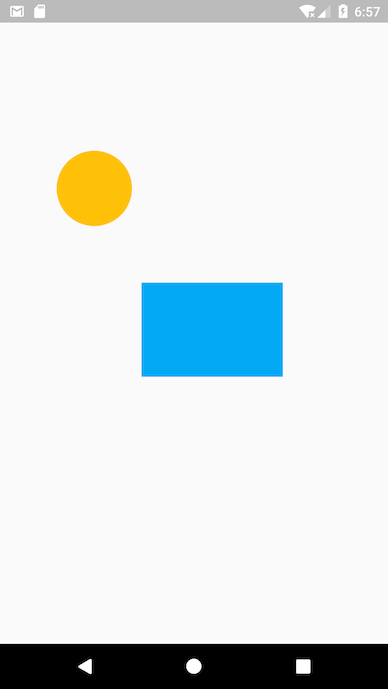

Layouts
How do I use widgets to define layout properties?
In React Native, most of the layout can be done with the props that are passed to a specific component. For example, you could use the style prop on the View component in order to specify the flexbox properties. To arrange your components in a column, you would specify a prop such as: flexDirection: "column".
// React Native < View style = {{ flex : 1 , flexDirection : ' column ' , justifyContent : ' space-between ' , alignItems : ' center ' }} > In Flutter, the layout is primarily defined by widgets specifically designed to provide layout, combined with control widgets and their style properties.
For example, the Column and Row widgets take an array of children and align them vertically and horizontally respectively. A Container widget takes a combination of layout and styling properties, and a Center widget centers its child widgets.
// Flutter Center ( child: Column ( children: < Widget >[ Container ( color: Colors . red , width: 100.0 , height: 100.0 , ), Container ( color: Colors . blue , width: 100.0 , height: 100.0 , ), Container ( color: Colors . green , width: 100.0 , height: 100.0 , ), ], ), ) Flutter provides a variety of layout widgets in its core widget library. For example, Padding, Align, and Stack.
For a complete list, see Layout Widgets.
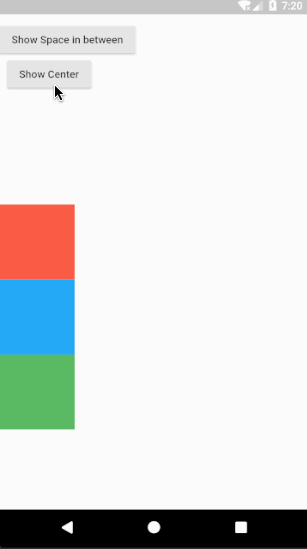

How do I layer widgets?
In React Native, components can be layered using absolute positioning.
Flutter uses the Stack widget to arrange children widgets in layers. The widgets can entirely or partially overlap the base widget.
The Stack widget positions its children relative to the edges of its box. This class is useful if you simply want to overlap several children widgets.
// Flutter Stack ( alignment: const Alignment ( 0.6 , 0.6 ), children: < Widget >[ CircleAvatar ( backgroundImage: NetworkImage ( 'https://avatars3.githubusercontent.com/u/14101776?v=4' ), ), Container ( decoration: BoxDecoration ( color: Colors . black45 , ), child: Text ( 'Flutter' ), ), ], ) The previous example uses Stack to overlay a Container (that displays its Text on a translucent black background) on top of a CircleAvatar. The Stack offsets the text using the alignment property and Alignment coordinates.


For more information, see the Stack class documentation.
Styling
How do I style my components?
In React Native, inline styling and stylesheets.create are used to style components.
// React Native < View style = { styles . container } > < Text style = {{ fontSize : 32 , color : ' cyan ' , fontWeight : ' 600 ' }} > This is a sample text < /Text > < /View > const styles = StyleSheet . create ({ container : { flex : 1 , backgroundColor : ' #fff ' , alignItems : ' center ' , justifyContent : ' center ' } }); In Flutter, a Text widget can take a TextStyle class for its style property. If you want to use the same text style in multiple places, you can create a TextStyle class and use it for multiple Text widgets.
// Flutter var textStyle = TextStyle ( fontSize: 32.0 , color: Colors . cyan , fontWeight: FontWeight . w600 ); ... Center ( child: Column ( children: < Widget >[ Text ( 'Sample text' , style: textStyle , ), Padding ( padding: EdgeInsets . all ( 20.0 ), child: Icon ( Icons . lightbulb_outline , size: 48.0 , color: Colors . redAccent ) ), ], ), ) 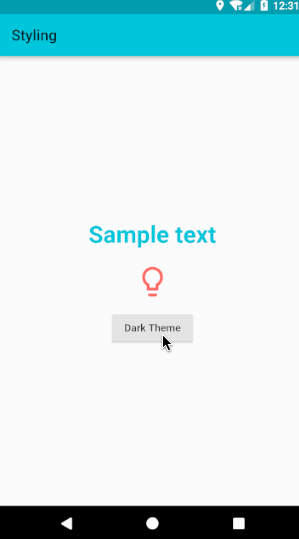

How do I use Icons and Colors?
React Native doesn't include support for icons so third party libraries are used.
In Flutter, importing the Material library also pulls in the rich set of Material icons and colors.
Icon ( Icons . lightbulb_outline , color: Colors . redAccent ) When using the Icons class, make sure to setuses-material-design: true in the project'spubspec.yaml file. This ensures that the MaterialIcons font, which displays the icons, is included in your app. In general, if you intend to use the Material library, you should include this line.
name : my_awesome_application flutter : uses-material-design : true Flutter's Cupertino (iOS-style) package provides high fidelity widgets for the current iOS design language. To use the CupertinoIcons font, add a dependency for cupertino_icons in your project's pubspec.yaml file.
name : my_awesome_application dependencies : cupertino_icons : ^0.1.0 To globally customize the colors and styles of components, use ThemeData to specify default colors for various aspects of the theme. Set the theme property in MaterialApp to the ThemeData object. The Colors class provides colors from the Material Design color palette.
The following example sets the primary swatch to blue and the text selection to red.
class SampleApp extends StatelessWidget { @override Widget build ( BuildContext context ) { return MaterialApp ( title: 'Sample App' , theme: ThemeData ( primarySwatch: Colors . blue , textSelectionColor: Colors . red ), home: SampleAppPage (), ); } } How do I add style themes?
In React Native, common themes are defined for components in stylesheets and then used in components.
In Flutter, create uniform styling for almost everything by defining the styling in the ThemeData class and passing it to the theme property in the MaterialApp widget.
@override Widget build ( BuildContext context ) { return MaterialApp ( theme: ThemeData ( primaryColor: Colors . cyan , brightness: Brightness . dark , ), home: StylingPage (), ); } A Theme can be applied even without using the MaterialApp widget. The Theme widget takes a ThemeData in its data parameter and applies the ThemeData to all of its children widgets.
@override Widget build ( BuildContext context ) { return Theme ( data: ThemeData ( primaryColor: Colors . cyan , brightness: brightness , ), child: Scaffold ( backgroundColor: Theme . of ( context ). primaryColor , ... ... ), ); } State management
State is information that can be read synchronously when a widget is built or information that might change during the lifetime of a widget. To manage app state in Flutter, use a StatefulWidget paired with a State object.
For more information on ways to approach managing state in Flutter, see State management.
The StatelessWidget
A StatelessWidget in Flutter is a widget that doesn't require a state change—it has no internal state to manage.
Stateless widgets are useful when the part of the user interface you are describing does not depend on anything other than the configuration information in the object itself and the BuildContext in which the widget is inflated.
AboutDialog, CircleAvatar, and Text are examples of stateless widgets that subclass StatelessWidget.
// Flutter import 'package:flutter/material.dart' ; void main ( ) => runApp ( MyStatelessWidget ( text: 'StatelessWidget Example to show immutable data' )); class MyStatelessWidget extends StatelessWidget { final String text ; MyStatelessWidget ({ Key key , this . text }) : super ( key: key ); @override Widget build ( BuildContext context ) { return Center ( child: Text ( text , textDirection: TextDirection . ltr , ), ); } } The previous example uses the constructor of the MyStatelessWidget class to pass the text, which is marked as final. This class extends StatelessWidget—it contains immutable data.
The build method of a stateless widget is typically called in only three situations:
- When the widget is inserted into a tree
- When the widget's parent changes its configuration
- When an
InheritedWidgetit depends on, changes
The StatefulWidget
A StatefulWidget is a widget that changes state. Use the setState method to manage the state changes for a StatefulWidget. A call to setState() tells the Flutter framework that something has changed in a state, which causes an app to rerun the build() method so that the app can reflect the change.
State is information that can be read synchronously when a widget is built and might change during the lifetime of the widget. It's the responsibility of the widget implementer to ensure that the state object is promptly notified when the state changes. Use StatefulWidget when a widget can change dynamically. For example, the state of the widget changes by typing into a form, or moving a slider. Or, it can change over time—perhaps a data feed updates the UI.
Checkbox, Radio, Slider, InkWell, Form, and TextField are examples of stateful widgets that subclass StatefulWidget.
The following example declares a StatefulWidget that requires a createState() method. This method creates the state object that manages the widget's state, _MyStatefulWidgetState.
class MyStatefulWidget extends StatefulWidget { MyStatefulWidget ({ Key key , this . title }) : super ( key: key ); final String title ; @override _MyStatefulWidgetState createState () => _MyStatefulWidgetState (); } The following state class, _MyStatefulWidgetState, implements the build() method for the widget. When the state changes, for example, when the user toggles the button, setState() is called with the new toggle value. This causes the framework to rebuild this widget in the UI.
class _MyStatefulWidgetState extends State < MyStatefulWidget > { bool showtext = true ; bool toggleState = true ; Timer t2 ; void toggleBlinkState (){ setState ((){ toggleState =! toggleState ; }); var twenty = const Duration ( milliseconds: 1000 ); if ( toggleState == false ) { t2 = Timer . periodic ( twenty , ( Timer t ) { toggleShowText (); }); } else { t2 . cancel (); } } void toggleShowText (){ setState ((){ showtext =! showtext ; }); } @override Widget build ( BuildContext context ) { return Scaffold ( body: Center ( child: Column ( children: < Widget >[ ( showtext ?( Text ( 'This execution will be done before you can blink.' )) :( Container ()) ), Padding ( padding: EdgeInsets . only ( top: 70.0 ), child: ElevatedButton ( onPressed: toggleBlinkState , child: ( toggleState ?( Text ( 'Blink' )) :( Text ( 'Stop Blinking' )) ) ) ) ], ), ), ); } } What are the StatefulWidget and StatelessWidget best practices?
Here are a few things to consider when designing your widget.
- Determine whether a widget should be a StatefulWidget or a StatelessWidget.
In Flutter, widgets are either Stateful or Stateless—depending on whether they depend on a state change.
- If a widget changes—the user interacts with it or a data feed interrupts the UI, then it's Stateful.
- If a widget is final or immutable, then it's Stateless.
- Determine which object manages the widget's state (for a StatefulWidget).
In Flutter, there are three primary ways to manage state:
- The widget manages its own state
- The parent widget manages the widget's state
- A mix-and-match approach
When deciding which approach to use, consider the following principles:
- If the state in question is user data, for example the checked or unchecked mode of a checkbox, or the position of a slider, then the state is best managed by the parent widget.
- If the state in question is aesthetic, for example an animation, then the widget itself best manages the state.
- When in doubt, let the parent widget manage the child widget's state.
- Subclass StatefulWidget and State.
The MyStatefulWidget class manages its own state—it extends StatefulWidget, it overrides the createState() method to create the State object, and the framework calls createState() to build the widget. In this example, createState() creates an instance of _MyStatefulWidgetState, which is implemented in the next best practice.
class MyStatefulWidget extends StatefulWidget { MyStatefulWidget ({ Key key , this . title }) : super ( key: key ); final String title ; @override _MyStatefulWidgetState createState () => _MyStatefulWidgetState (); } class _MyStatefulWidgetState extends State < MyStatefulWidget > { @override Widget build ( BuildContext context ) { ... } } - Add the StatefulWidget into the widget tree.
Add your custom StatefulWidget to the widget tree in the app's build method.
class MyStatelessWidget extends StatelessWidget { // This widget is the root of your application. @override Widget build ( BuildContext context ) { return MaterialApp ( title: 'Flutter Demo' , theme: ThemeData ( primarySwatch: Colors . blue , ), home: MyStatefulWidget ( title: 'State Change Demo' ), ); } } 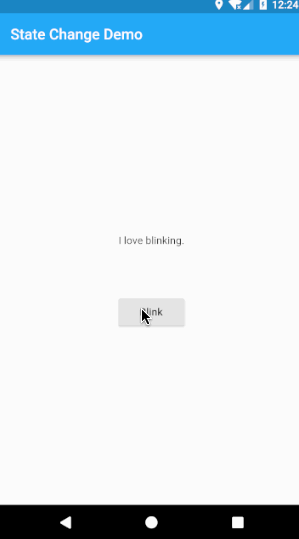

Props
In React Native, most components can be customized when they are created with different parameters or properties, called props. These parameters can be used in a child component using this.props.
// React Native class CustomCard extends React . Component { render () { return ( < View > < Text > Card { this . props . index } < /Text > < Button title = ' Press ' onPress = {() => this . props . onPress ( this . props . index )} / > < /View > ); } } class App extends React . Component { onPress = index => { console . log ( ' Card ' , index ); }; render () { return ( < View > < FlatList data = {[ ... ]} renderItem = {({ item }) => ( < CustomCard onPress = { this . onPress } index = { item . key } / > )} / > < /View > ); } } In Flutter, you assign a local variable or function marked final with the property received in the parameterized constructor.
// Flutter class CustomCard extends StatelessWidget { CustomCard ({ @required this . index , @required this . onPress }); final index ; final Function onPress ; @override Widget build ( BuildContext context ) { return Card ( child: Column ( children: < Widget >[ Text ( 'Card $index ' ), TextButton ( child: const Text ( 'Press' ), onPressed: this . onPress , ), ], )); } } ... //Usage CustomCard ( index: index , onPress: () { print ( 'Card $index ' ); }, ) 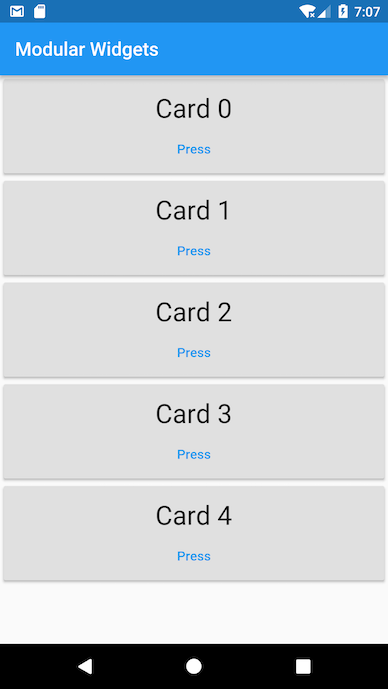

Local storage
If you don't need to store a lot of data and it doesn't require structure, you can use shared_preferences which allows you to read and write persistent key-value pairs of primitive data types: booleans, floats, ints, longs, and strings.
How do I store persistent key-value pairs that are global to the app?
In React Native, you use the setItem and getItem functions of the AsyncStorage component to store and retrieve data that is persistent and global to the app.
// React Native await AsyncStorage . setItem ( ' counterkey ' , json . stringify ( ++ this . state . counter )); AsyncStorage . getItem ( ' counterkey ' ). then ( value => { if ( value != null ) { this . setState ({ counter : value }); } }); In Flutter, use the shared_preferences plugin to store and retrieve key-value data that is persistent and global to the app. The shared_preferences plugin wraps NSUserDefaults on iOS and SharedPreferences on Android, providing a persistent store for simple data. To use the plugin, add shared_preferences as a dependency in the pubspec.yaml file then import the package in your Dart file.
dependencies : flutter : sdk : flutter shared_preferences : ^0.4.3 // Dart import 'package:shared_preferences/shared_preferences.dart' ; To implement persistent data, use the setter methods provided by the SharedPreferences class. Setter methods are available for various primitive types, such as setInt, setBool, and setString. To read data, use the appropriate getter method provided by the SharedPreferences class. For each setter there is a corresponding getter method, for example, getInt, getBool, and getString.
SharedPreferences prefs = await SharedPreferences . getInstance (); _counter = prefs . getInt ( 'counter' ); prefs . setInt ( 'counter' , ++ _counter ); setState (() { _counter = _counter ; }); Routing
Most apps contain several screens for displaying different types of information. For example, you might have a product screen that displays images where users could tap on a product image to get more information about the product on a new screen.
In Android, new screens are new Activities. In iOS, new screens are new ViewControllers. In Flutter, screens are just Widgets! And to navigate to new screens in Flutter, use the Navigator widget.
How do I navigate between screens?
In React Native, there are three main navigators: StackNavigator, TabNavigator, and DrawerNavigator. Each provides a way to configure and define the screens.
// React Native const MyApp = TabNavigator ( { Home : { screen : HomeScreen }, Notifications : { screen : tabNavScreen } }, { tabBarOptions : { activeTintColor : ' #e91e63 ' } } ); const SimpleApp = StackNavigator ({ Home : { screen : MyApp }, stackScreen : { screen : StackScreen } }); export default ( MyApp1 = DrawerNavigator ({ Home : { screen : SimpleApp }, Screen2 : { screen : drawerScreen } })); In Flutter, there are two main widgets used to navigate between screens:
- A
Routeis an abstraction for an app screen or page. - A
Navigatoris a widget that manages routes.
A Navigator is defined as a widget that manages a set of child widgets with a stack discipline. The navigator manages a stack of Route objects and provides methods for managing the stack, like Navigator.push and Navigator.pop. A list of routes might be specified in the MaterialApp widget, or they might be built on the fly, for example, in hero animations. The following example specifies named routes in the MaterialApp widget.
// Flutter class NavigationApp extends StatelessWidget { // This widget is the root of your application. @override Widget build ( BuildContext context ) { return MaterialApp ( ... routes: < String , WidgetBuilder >{ '/a' : ( BuildContext context ) => usualNavscreen (), '/b' : ( BuildContext context ) => drawerNavscreen (), } ... ); } } To navigate to a named route, the Navigator.of() method is used to specify the BuildContext (a handle to the location of a widget in the widget tree). The name of the route is passed to the pushNamed function to navigate to the specified route.
Navigator . of ( context ). pushNamed ( '/a' ); You can also use the push method of Navigator which adds the given Route to the history of the navigator that most tightly encloses the given BuildContext, and transitions to it. In the following example, the MaterialPageRoute widget is a modal route that replaces the entire screen with a platform-adaptive transition. It takes a WidgetBuilder as a required parameter.
Navigator . push ( context , MaterialPageRoute ( builder: ( BuildContext context ) => UsualNavscreen ())); How do I use tab navigation and drawer navigation?
In Material Design apps, there are two primary options for Flutter navigation: tabs and drawers. When there is insufficient space to support tabs, drawers provide a good alternative.
Tab navigation
In React Native, createBottomTabNavigator and TabNavigation are used to show tabs and for tab navigation.
// React Native import { createBottomTabNavigator } from ' react-navigation ' ; const MyApp = TabNavigator ( { Home : { screen : HomeScreen }, Notifications : { screen : tabNavScreen } }, { tabBarOptions : { activeTintColor : ' #e91e63 ' } } ); Flutter provides several specialized widgets for drawer and tab navigation:
-
TabController - Coordinates the tab selection between a
TabBarand aTabBarView. -
TabBar - Displays a horizontal row of tabs.
-
Tab - Creates a material design TabBar tab.
-
TabBarView - Displays the widget that corresponds to the currently selected tab.
// Flutter TabController controller = TabController ( length: 2 , vsync: this ); TabBar ( tabs: < Tab >[ Tab ( icon: Icon ( Icons . person ),), Tab ( icon: Icon ( Icons . email ),), ], controller: controller , ), A TabController is required to coordinate the tab selection between a TabBar and a TabBarView. The TabController constructor length argument is the total number of tabs. A TickerProvider is required to trigger the notification whenever a frame triggers a state change. The TickerProvider is vsync. Pass the vsync: this argument to the TabController constructor whenever you create a new TabController.
The TickerProvider is an interface implemented by classes that can vend Ticker objects. Tickers can be used by any object that must be notified whenever a frame triggers, but they're most commonly used indirectly via an AnimationController. AnimationControllers need a TickerProvider to obtain their Ticker. If you are creating an AnimationController from a State, then you can use the TickerProviderStateMixin or SingleTickerProviderStateMixin classes to obtain a suitable TickerProvider.
The Scaffold widget wraps a new TabBar widget and creates two tabs. The TabBarView widget is passed as the body parameter of the Scaffold widget. All screens corresponding to the TabBar widget's tabs are children to the TabBarView widget along with the same TabController.
// Flutter class _NavigationHomePageState extends State < NavigationHomePage > with SingleTickerProviderStateMixin { TabController controller = TabController ( length: 2 , vsync: this ); @override Widget build ( BuildContext context ) { return Scaffold ( bottomNavigationBar: Material ( child: TabBar ( tabs: < Tab > [ Tab ( icon: Icon ( Icons . person ),) Tab ( icon: Icon ( Icons . email ),), ], controller: controller , ), color: Colors . blue , ), body: TabBarView ( children: < Widget > [ home . homeScreen (), tabScreen . tabScreen () ], controller: controller , ) ); } } Drawer navigation
In React Native, import the needed react-navigation packages and then use createDrawerNavigator and DrawerNavigation.
// React Native export default ( MyApp1 = DrawerNavigator ({ Home : { screen : SimpleApp }, Screen2 : { screen : drawerScreen } })); In Flutter, we can use the Drawer widget in combination with a Scaffold to create a layout with a Material Design drawer. To add a Drawer to an app, wrap it in a Scaffold widget. The Scaffold widget provides a consistent visual structure to apps that follow the Material Design guidelines. It also supports special Material Design components, such as Drawers, AppBars, and SnackBars.
The Drawer widget is a Material Design panel that slides in horizontally from the edge of a Scaffold to show navigation links in an application. You can provide a ElevatedButton, a Text widget, or a list of items to display as the child to the Drawer widget. In the following example, the ListTile widget provides the navigation on tap.
// Flutter Drawer ( child: ListTile ( leading: Icon ( Icons . change_history ), title: Text ( 'Screen2' ), onTap: () { Navigator . of ( context ). pushNamed ( '/b' ); }, ), elevation: 20.0 , ), The Scaffold widget also includes an AppBar widget that automatically displays an appropriate IconButton to show the Drawer when a Drawer is available in the Scaffold. The Scaffold automatically handles the edge-swipe gesture to show the Drawer.
// Flutter @override Widget build ( BuildContext context ) { return Scaffold ( drawer: Drawer ( child: ListTile ( leading: Icon ( Icons . change_history ), title: Text ( 'Screen2' ), onTap: () { Navigator . of ( context ). pushNamed ( '/b' ); }, ), elevation: 20.0 , ), appBar: AppBar ( title: Text ( 'Home' ), ), body: Container (), ); } 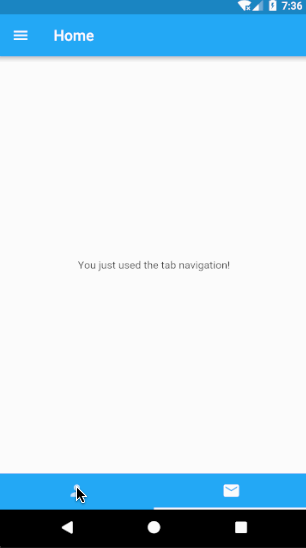

Gesture detection and touch event handling
To listen for and respond to gestures, Flutter supports taps, drags, and scaling. The gesture system in Flutter has two separate layers. The first layer includes raw pointer events, which describe the location and movement of pointers, (such as touches, mice, and styli movements), across the screen. The second layer includes gestures, which describe semantic actions that consist of one or more pointer movements.
How do I add a click or press listeners to a widget?
In React Native, listeners are added to components using PanResponder or the Touchable components.
// React Native < TouchableOpacity onPress = {() => { console . log ( ' Press ' ); }} onLongPress = {() => { console . log ( ' Long Press ' ); }} > < Text > Tap or Long Press < /Text > < /TouchableOpacity > For more complex gestures and combining several touches into a single gesture, PanResponder is used.
// React Native class App extends Component { componentWillMount () { this . _panResponder = PanResponder . create ({ onMoveShouldSetPanResponder : ( event , gestureState ) => !! getDirection ( gestureState ), onPanResponderMove : ( event , gestureState ) => true , onPanResponderRelease : ( event , gestureState ) => { const drag = getDirection ( gestureState ); }, onPanResponderTerminationRequest : ( event , gestureState ) => true }); } render () { return ( < View style = { styles . container } {... this . _panResponder . panHandlers } > < View style = { styles . center } > < Text > Swipe Horizontally or Vertically < /Text > < /View > < /View > ); } } In Flutter, to add a click (or press) listener to a widget, use a button or a touchable widget that has an onPress: field. Or, add gesture detection to any widget by wrapping it in a GestureDetector.
// Flutter GestureDetector ( child: Scaffold ( appBar: AppBar ( title: Text ( 'Gestures' ), ), body: Center ( child: Column ( mainAxisAlignment: MainAxisAlignment . center , children: < Widget >[ Text ( 'Tap, Long Press, Swipe Horizontally or Vertically ' ), ], ) ), ), onTap: () { print ( 'Tapped' ); }, onLongPress: () { print ( 'Long Pressed' ); }, onVerticalDragEnd: ( DragEndDetails value ) { print ( 'Swiped Vertically' ); }, onHorizontalDragEnd: ( DragEndDetails value ) { print ( 'Swiped Horizontally' ); }, ); For more information, including a list of Flutter GestureDetector callbacks, see the GestureDetector class.
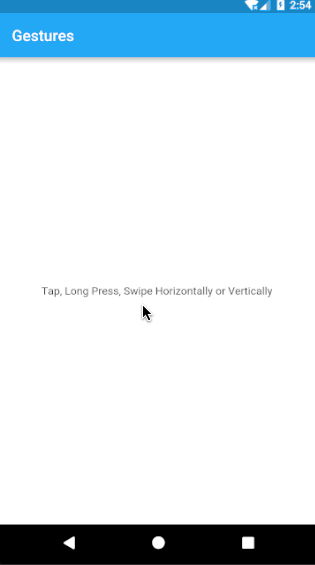

Making HTTP network requests
Fetching data from the internet is common for most apps. And in Flutter, the http package provides the simplest way to fetch data from the internet.
How do I fetch data from API calls?
React Native provides the Fetch API for networking—you make a fetch request and then receive the response to get the data.
// React Native _getIPAddress = () => { fetch ( ' https://httpbin.org/ip ' ) . then ( response => response . json ()) . then ( responseJson => { this . setState ({ _ipAddress : responseJson . origin }); }) . catch ( error => { console . error ( error ); }); }; Flutter uses the http package. To install the http package, add it to the dependencies section of our pubspec.yaml.
dependencies : flutter : sdk : flutter http : <latest_version> Flutter uses the dart:io core HTTP support client. To create an HTTP Client, import dart:io.
The client supports the following HTTP operations: GET, POST, PUT, and DELETE.
// Flutter final url = Uri . parse ( 'https://httpbin.org/ip' ); final httpClient = HttpClient (); _getIPAddress () async { var request = await httpClient . getUrl ( url ); var response = await request . close (); var responseBody = await response . transform ( utf8 . decoder ). join (); String ip = jsonDecode ( responseBody )[ 'origin' ]; setState (() { _ipAddress = ip ; }); } 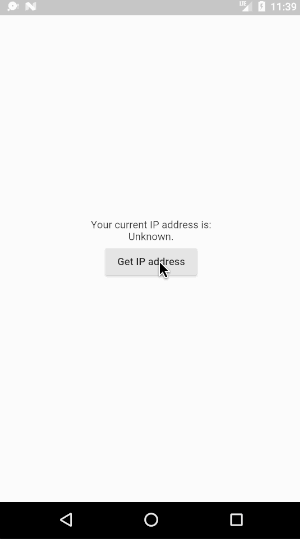

Form input
Text fields allow users to type text into your app so they can be used to build forms, messaging apps, search experiences, and more. Flutter provides two core text field widgets: TextField and TextFormField.
How do I use text field widgets?
In React Native, to enter text you use a TextInput component to show a text input box and then use the callback to store the value in a variable.
// React Native < TextInput placeholder = " Enter your Password " onChangeText = { password => this . setState ({ password })} / > < Button title = " Submit " onPress = { this . validate } / > In Flutter, use the TextEditingController class to manage a TextField widget. Whenever the text field is modified, the controller notifies its listeners.
Listeners read the text and selection properties to learn what the user typed into the field. You can access the text in TextField by the text property of the controller.
// Flutter final TextEditingController _controller = TextEditingController (); ... TextField ( controller: _controller , decoration: InputDecoration ( hintText: 'Type something' , labelText: 'Text Field ' ), ), ElevatedButton ( child: Text ( 'Submit' ), onPressed: () { showDialog ( context: context , child: AlertDialog ( title: Text ( 'Alert' ), content: Text ( 'You typed ${_controller.text} ' ), ), ); }, ), ) In this example, when a user clicks on the submit button an alert dialog displays the current text entered in the text field. This is achieved using an alertDialog widget that displays the alert message, and the text from the TextField is accessed by the text property of the TextEditingController.
How do I use Form widgets?
In Flutter, use the Form widget where TextFormField widgets along with the submit button are passed as children. The TextFormField widget has a parameter called onSaved that takes a callback and executes when the form is saved. A FormState object is used to save, reset, or validate each FormField that is a descendant of this Form. To obtain the FormState, you can use Form.of() with a context whose ancestor is the Form, or pass a GlobalKey to the Form constructor and call GlobalKey.currentState().
final formKey = GlobalKey < FormState >(); ... Form ( key: formKey , child: Column ( children: < Widget >[ TextFormField ( validator: ( value ) => ! value . contains ( '@' ) ? 'Not a valid email.' : null , onSaved: ( val ) => _email = val , decoration: const InputDecoration ( hintText: 'Enter your email' , labelText: 'Email' , ), ), ElevatedButton ( onPressed: _submit , child: Text ( 'Login' ), ), ], ), ) The following example shows how Form.save() and formKey (which is a GlobalKey) are used to save the form on submit.
void _submit ( ) { final form = formKey . currentState ; if ( form . validate ()) { form . save (); showDialog ( context: context , child: AlertDialog ( title: Text ( 'Alert' ), content: Text ( 'Email: $_email , password: $_password ' ), ) ); } } 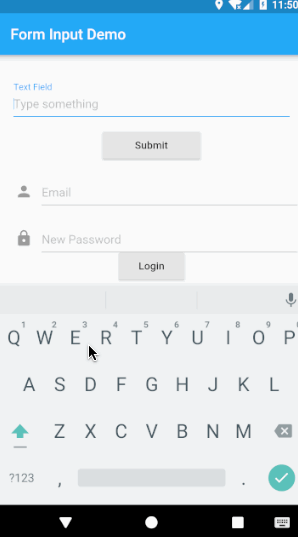

Platform-specific code
When building a cross-platform app, you want to re-use as much code as possible across platforms. However, scenarios might arise where it makes sense for the code to be different depending on the OS. This requires a separate implementation by declaring a specific platform.
In React Native, the following implementation would be used:
// React Native if ( Platform . OS === ' ios ' ) { return ' iOS ' ; } else if ( Platform . OS === ' android ' ) { return ' android ' ; } else { return ' not recognised ' ; } In Flutter, use the following implementation:
// Flutter if ( Theme . of ( context ). platform == TargetPlatform . iOS ) { return 'iOS' ; } else if ( Theme . of ( context ). platform == TargetPlatform . android ) { return 'android' ; } else if ( Theme . of ( context ). platform == TargetPlatform . fuchsia ) { return 'fuchsia' ; } else { return 'not recognised ' ; } Debugging
What tools can I use to debug my app in Flutter?
Use the DevTools suite for debugging Flutter or Dart apps.
DevTools includes support for profiling, examining the heap, inspecting the widget tree, logging diagnostics, debugging, observing executed lines of code, debugging memory leaks and memory fragmentation. For more information, see the DevTools documentation.
If you're using an IDE, you can debug your application using the IDE's debugger.
How do I perform a hot reload?
Flutter's Stateful Hot Reload feature helps you quickly and easily experiment, build UIs, add features, and fix bugs. Instead of recompiling your app every time you make a change, you can hot reload your app instantly. The app is updated to reflect your change, and the current state of the app is preserved.
In React Native, the shortcut is ⌘R for the iOS Simulator and tapping R twice on Android emulators.
In Flutter, If you are using IntelliJ IDE or Android Studio, you can select Save All (⌘s/ctrl-s), or you can click the Hot Reload button on the toolbar. If you are running the app at the command line using flutter run, type r in the Terminal window. You can also perform a full restart by typing R in the Terminal window.
In React Native, the developer menu can be accessed by shaking your device: ⌘D for the iOS Simulator or ⌘M for Android emulator.
In Flutter, if you are using an IDE, you can use the IDE tools. If you start your application using flutter run you can also access the menu by typing h in the terminal window, or type the following shortcuts:
| Action | Terminal Shortcut | Debug functions and properties |
|---|---|---|
| Widget hierarchy of the app | w | debugDumpApp() |
| Rendering tree of the app | t | debugDumpRenderTree() |
| Layers | L | debugDumpLayerTree() |
| Accessibility | S (traversal order) orU (inverse hit test order) | debugDumpSemantics() |
| To toggle the widget inspector | i | WidgetsApp. showWidgetInspectorOverride |
| To toggle the display of construction lines | p | debugPaintSizeEnabled |
| To simulate different operating systems | o | defaultTargetPlatform |
| To display the performance overlay | P | WidgetsApp. showPerformanceOverlay |
| To save a screenshot to flutter. png | s | |
| To quit | q |
Animation
Well-designed animation makes a UI feel intuitive, contributes to the look and feel of a polished app, and improves the user experience. Flutter's animation support makes it easy to implement simple and complex animations. The Flutter SDK includes many Material Design widgets that include standard motion effects and you can easily customize these effects to personalize your app.
In React Native, Animated APIs are used to create animations.
In Flutter, use the Animation class and the AnimationController class. Animation is an abstract class that understands its current value and its state (completed or dismissed). The AnimationController class lets you play an animation forward or in reverse, or stop animation and set the animation to a specific value to customize the motion.
How do I add a simple fade-in animation?
In the React Native example below, an animated component, FadeInView is created using the Animated API. The initial opacity state, final state, and the duration over which the transition occurs are defined. The animation component is added inside the Animated component, the opacity state fadeAnim is mapped to the opacity of the Text component that we want to animate, and then, start() is called to start the animation.
// React Native class FadeInView extends React . Component { state = { fadeAnim : new Animated . Value ( 0 ) // Initial value for opacity: 0 }; componentDidMount () { Animated . timing ( this . state . fadeAnim , { toValue : 1 , duration : 10000 }). start (); } render () { return ( < Animated . View style = {{... this . props . style , opacity : this . state . fadeAnim }} > { this . props . children } < /Animated.View > ); } } ... < FadeInView > < Text > Fading in < /Text > < /FadeInView > ... To create the same animation in Flutter, create an AnimationController object named controller and specify the duration. By default, an AnimationController linearly produces values that range from 0.0 to 1.0, during a given duration. The animation controller generates a new value whenever the device running your app is ready to display a new frame. Typically, this rate is around 60 values per second.
When defining an AnimationController, you must pass in a vsync object. The presence of vsync prevents offscreen animations from consuming unnecessary resources. You can use your stateful object as the vsync by adding TickerProviderStateMixin to the class definition. An AnimationController needs a TickerProvider, which is configured using the vsync argument on the constructor.
A Tween describes the interpolation between a beginning and ending value or the mapping from an input range to an output range. To use a Tween object with an animation, call the Tween object's animate() method and pass it the Animation object that you want to modify.
For this example, a FadeTransition widget is used and the opacity property is mapped to the animation object.
To start the animation, use controller.forward(). Other operations can also be performed using the controller such as fling() or repeat(). For this example, the FlutterLogo widget is used inside the FadeTransition widget.
// Flutter import 'package:flutter/material.dart' ; void main ( ) { runApp ( Center ( child: LogoFade ())); } class LogoFade extends StatefulWidget { _LogoFadeState createState () => _LogoFadeState (); } class _LogoFadeState extends State < LogoFade > with TickerProviderStateMixin { Animation animation ; AnimationController controller ; initState () { super . initState (); controller = AnimationController ( duration: const Duration ( milliseconds: 3000 ), vsync: this ); final CurvedAnimation curve = CurvedAnimation ( parent: controller , curve: Curves . easeIn ); animation = Tween ( begin: 0.0 , end: 1.0 ). animate ( curve ); controller . forward (); } Widget build ( BuildContext context ) { return FadeTransition ( opacity: animation , child: Container ( height: 300.0 , width: 300.0 , child: FlutterLogo (), ), ); } dispose () { controller . dispose (); super . dispose (); } } 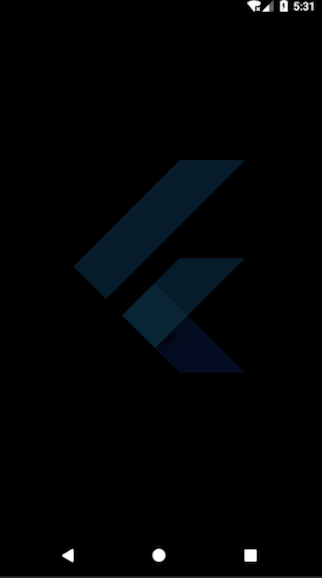

How do I add swipe animation to cards?
In React Native, either the PanResponder or third-party libraries are used for swipe animation.
In Flutter, to add a swipe animation, use the Dismissible widget and nest the child widgets.
child: Dismissible ( key: key , onDismissed: ( DismissDirection dir ) { cards . removeLast (); }, child: Container ( ... ), ), 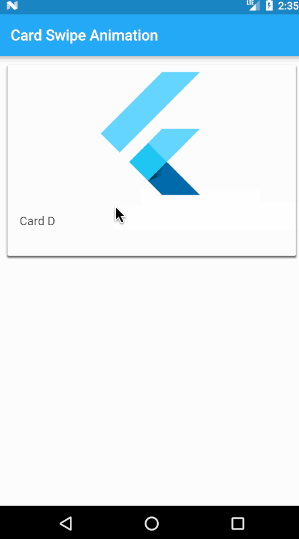

The following table lists commonly-used React Native components mapped to the corresponding Flutter widget and common widget properties.
| React Native Component | Flutter Widget | Description |
|---|---|---|
Button | ElevatedButton | A basic raised button. |
| onPressed [required] | The callback when the button is tapped or otherwise activated. | |
| Child | The button's label. | |
Button | TextButton | A basic flat button. |
| onPressed [required] | The callback when the button is tapped or otherwise activated. | |
| Child | The button's label. | |
ScrollView | ListView | A scrollable list of widgets arranged linearly. |
| children | ( <Widget> [ ]) List of child widgets to display. | |
| controller | [ ScrollController ] An object that can be used to control a scrollable widget. | |
| itemExtent | [ double ] If non-null, forces the children to have the given extent in the scroll direction. | |
| scroll Direction | [ Axis ] The axis along which the scroll view scrolls. | |
FlatList | ListView.builder | The constructor for a linear array of widgets that are created on demand. |
| itemBuilder [required] | [IndexedWidgetBuilder] helps in building the children on demand. This callback is called only with indices greater than or equal to zero and less than the itemCount. | |
| itemCount | [ int ] improves the ability of the ListView to estimate the maximum scroll extent. | |
Image | Image | A widget that displays an image. |
| image [required] | The image to display. | |
| Image. asset | Several constructors are provided for the various ways that an image can be specified. | |
| width, height, color, alignment | The style and layout for the image. | |
| fit | Inscribing the image into the space allocated during layout. | |
Modal | ModalRoute | A route that blocks interaction with previous routes. |
| animation | The animation that drives the route's transition and the previous route's forward transition. | |
ActivityIndicator | CircularProgressIndicator | A widget that shows progress along a circle. |
| strokeWidth | The width of the line used to draw the circle. | |
| backgroundColor | The progress indicator's background color. The current theme's ThemeData.backgroundColor by default. | |
ActivityIndicator | LinearProgressIndicator | A widget that shows progress along a line. |
| value | The value of this progress indicator. | |
RefreshControl | RefreshIndicator | A widget that supports the Material "swipe to refresh" idiom. |
| color | The progress indicator's foreground color. | |
| onRefresh | A function that's called when a user drags the refresh indicator far enough to demonstrate that they want the app to refresh. | |
View | Container | A widget that surrounds a child widget. |
View | Column | A widget that displays its children in a vertical array. |
View | Row | A widget that displays its children in a horizontal array. |
View | Center | A widget that centers its child within itself. |
View | Padding | A widget that insets its child by the given padding. |
| padding [required] | [ EdgeInsets ] The amount of space to inset the child. | |
TouchableOpacity | GestureDetector | A widget that detects gestures. |
| onTap | A callback when a tap occurs. | |
| onDoubleTap | A callback when a tap occurs at the same location twice in quick succession. | |
TextInput | TextInput | The interface to the system's text input control. |
| controller | [ TextEditingController ] used to access and modify text. | |
Text | Text | The Text widget that displays a string of text with a single style. |
| data | [ String ] The text to display. | |
| textDirection | [ TextAlign ] The direction in which the text flows. | |
Switch | Switch | A material design switch. |
| value [required] | [ boolean ] Whether this switch is on or off. | |
| onChanged [required] | [ callback ] Called when the user toggles the switch on or off. | |
Slider | Slider | Used to select from a range of values. |
| value [required] | [ double ] The current value of the slider. | |
| onChanged [required] | Called when the user selects a new value for the slider. |
How To Pass An Api Key From Outside Your App Tree
Source: https://docs.flutter.dev/get-started/flutter-for/react-native-devs
Posted by: ortiztaide1983.blogspot.com

0 Response to "How To Pass An Api Key From Outside Your App Tree"
Post a Comment